A Brief Overview


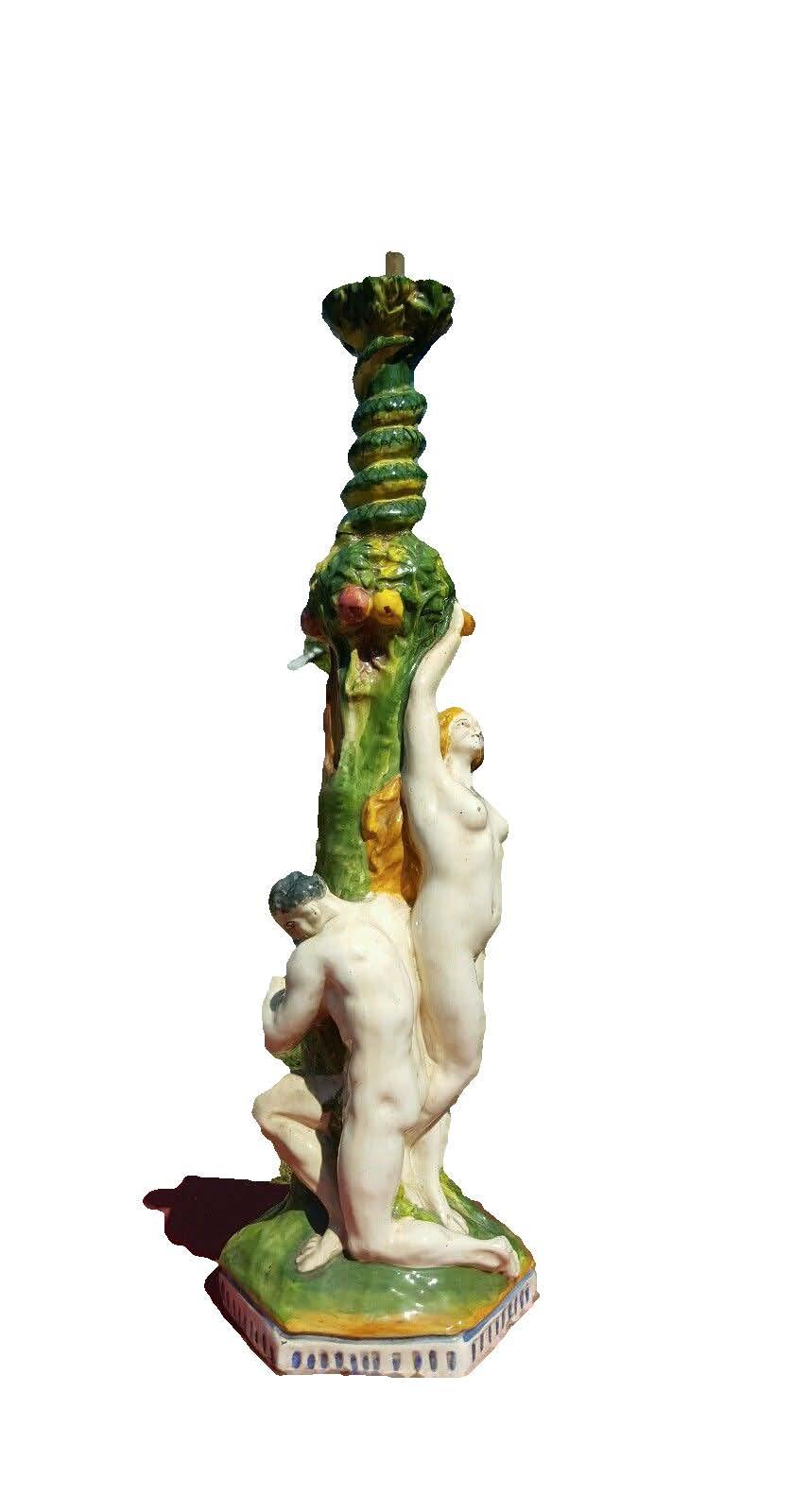






Copyright Yuko Nii Foundation 2016


CONTENTS

P 4-5 Illustrations for Paradise Lost circa 1800
P 6 Planned Giving and naming rights to support the landmark building and collections
P 7 The landmarked building
P 8-14 Some of the historical items in the Milton collection
P 15-25 The core of the collection, the Terrance Lindall productions
P 26-38 The Madam Pomfret and Fuseli Paradise Lost Books
P 39-48 Other Lindall Productions, The Gold Folio Catalog and Giclee Prints, etc.
The Expulsion, pencil on paper, circa 1800, Unknown artist Collection of the Yuko Nii Foundation
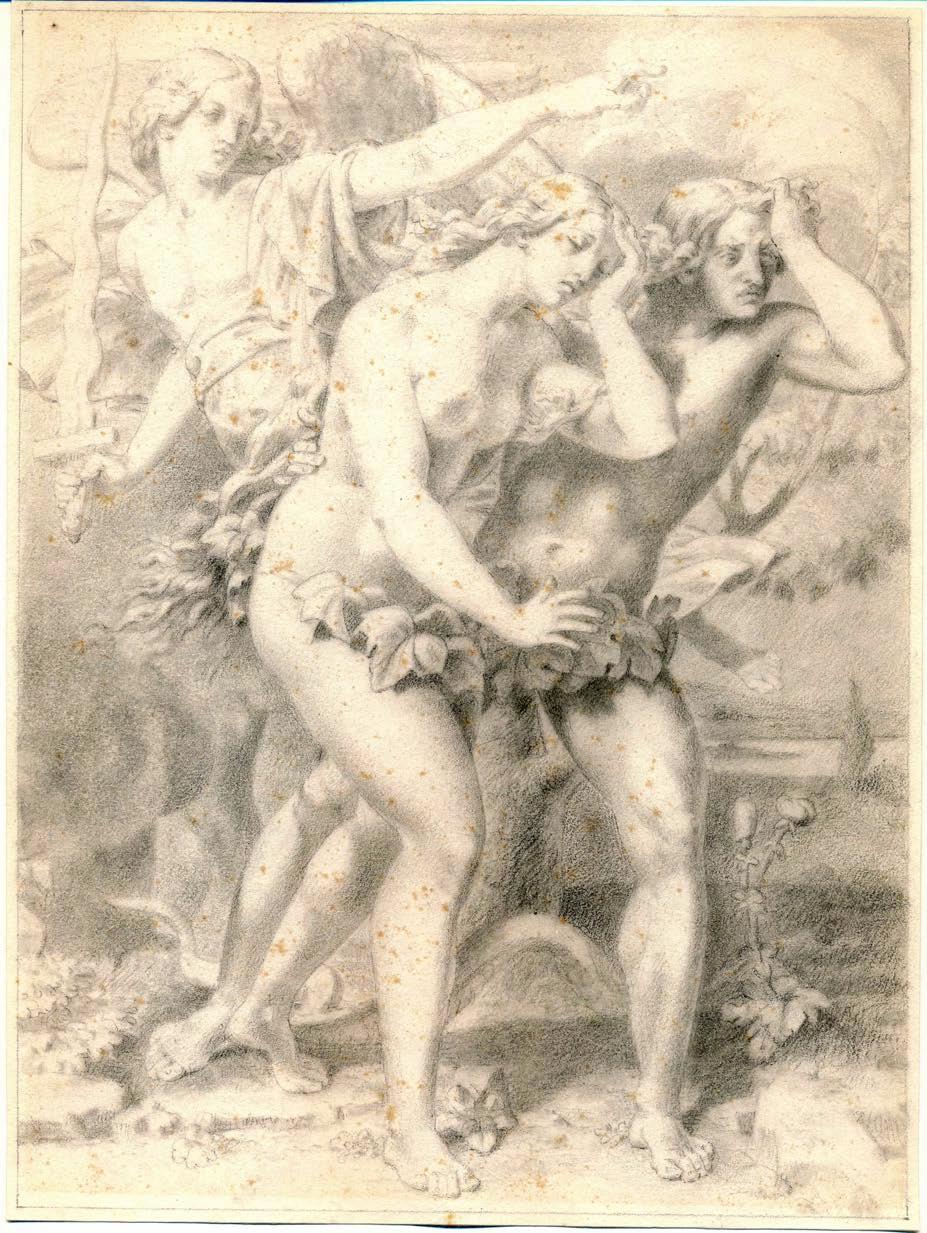
Eve Picks Fruit, pencil on paper, circa 1800, Unknown artist Collection of the Yuko Nii Foundation

Planned Giving/Bequest

Members and friends may support upkeep of our landmark building and its collections in a number of ways. The most common forms of giving are outright gifts of cash and securities, but there are other types of assets that may be donated as well and planned giving options that have favorable financial and tax benefits.
Today planned gifts are more important than ever to the WAH Center’s stability and future success. The term "planned giving" refers to any major gift that involves financial or estate planning. Such gifts can provide important benefits both to you and to the WAH Center. The different types of planned gifts include bequests, life income plans (charitable gift annuities and charitable remainder trusts), charitable lead trusts, gifts of life insurance policies, and gifts of tangible personal property. The Williamsburg Circle is the recognition society for individuals who have chosen to make planned gifts to The WAH Center.
We would be pleased to work with you and your advisors to structure a gift that best fulfills your charitable goals. Before making a gift to The Yuko Nii Foundation, you should consult with your financial, tax, and legal advisors for a thorough analysis of your individual situation and the tax consequences and to decide which of these ways of giving might work best for you.
Naming Rights
Major donors can name parts of the building, such as “The John Doe Grand Reception Hall. “Please inquire.
Above is the home of the Yuko Nii Foundation (YNF), the repository of the paintings, writings of renowned Paradise lost illustrator Terrance Lindall. The building is on the national Register of historic Places and the 7th building in all of New York to be landmarked.

The YNF is seeking a capital fund of $3,000,000 to install an elevator to its mansard roof and build its archive room and $2,000,000 to endow the collections.
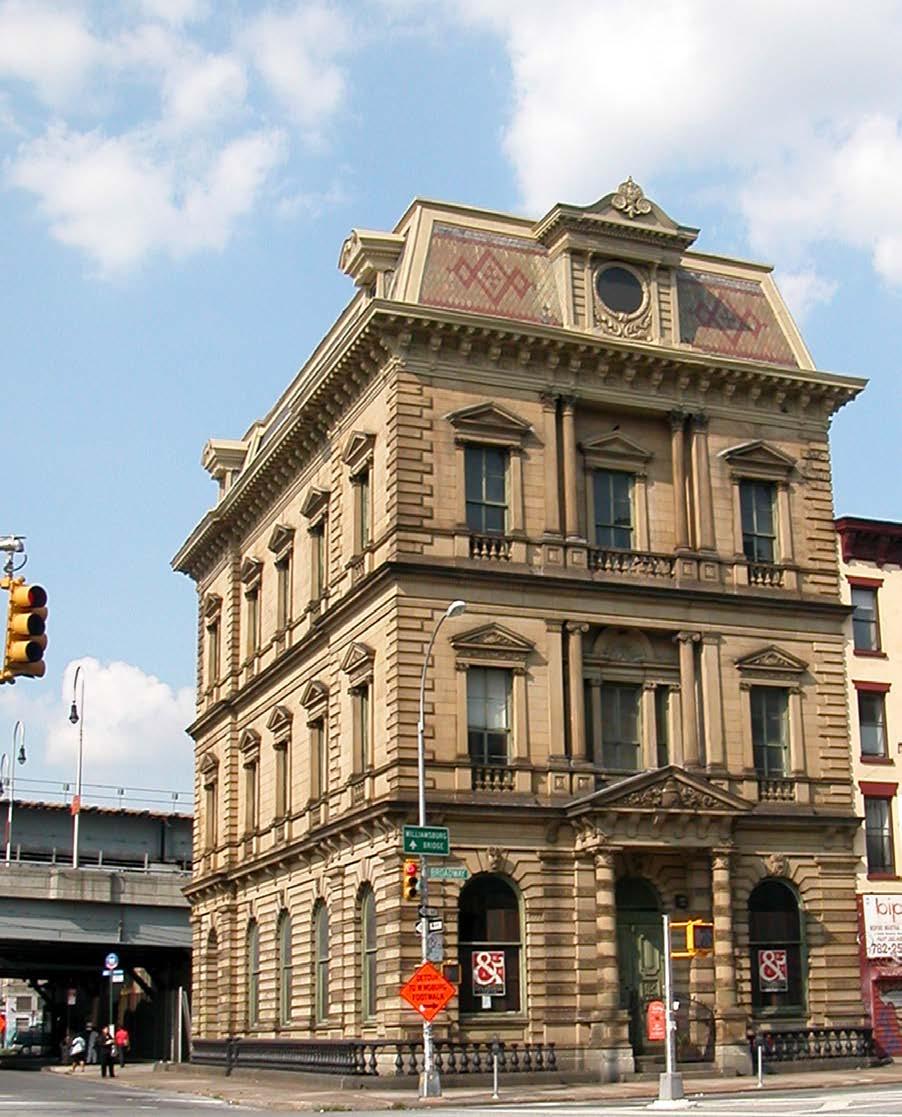
A LOOK AT SOME OF THE YUKO NII FOUNDATIONS MILTON RELATED COLLECTIONS


These YNF alabasters replicas of the Autun Cathedral Adam and Eve lintels were probably done while the Autun lintels were intact before or after the 15th century fire or before the 18th century “redecorating” and plastering or even the possible French Revolution smashing, which means somewhere between the 15th and 18th centuries, or even back further to the 12th century. The YNF alabaster may be the only surviving replica of this Gislebe rtus Adam masterpiece, which makes it significant.

Left: cherry wood sculpture of Eve circa 1940 by McNeil Smith





 Right: 17th C. Torah Scroll of the Book of Genesis, 23 feet long
Right: 17th C. Torah Scroll of the Book of Genesis, 23 feet long
This is an early 19th C. Georgian traveling desk. A wealthy lady or gentleman could do their correspondence while on their coach or staying at an inn on the road. The miniature portrait of John Milton is 18th/19th C. on ivory.

Right: Letter from renowned Henry John Todd (1763–1845). Todd was an English clergyman, librarian, and scholar, known as an editor of John Milton. He was librarian at Lambeth Palace. The letter by Todd from Lambeth Castle references the Jerusalem Manuscripts.





Colonel’s uniform, Empress of India Regiment, 19th C., Coat of the Herald of Queen Elizabeth II, Letter from Queen Elizabeth II to the Lord Chamberlain, Sword of the household of King Edward VIII










Cabinet contains left to right: The Traveling Elephant Folio. The Gold Folio of Paradise Lost and the Satanic verses of Bones Banez





















Above: The YNF’s 19th c. oil Portrait of Milton dictating Paradise Lost to his daughters at Milton’s Cottage. Milton’s Cottage Trust (CIO) is a Registered Charity 1163039 21 Deanway, Chalfont St Giles, Buckinghamshire, HP8 4JH, England
Above is the “Harmless Innocence” page from the Yuko Nii Foundation Gold Elephant Folio. It is also the cover for the Cambridge Companion to Paradise Lost



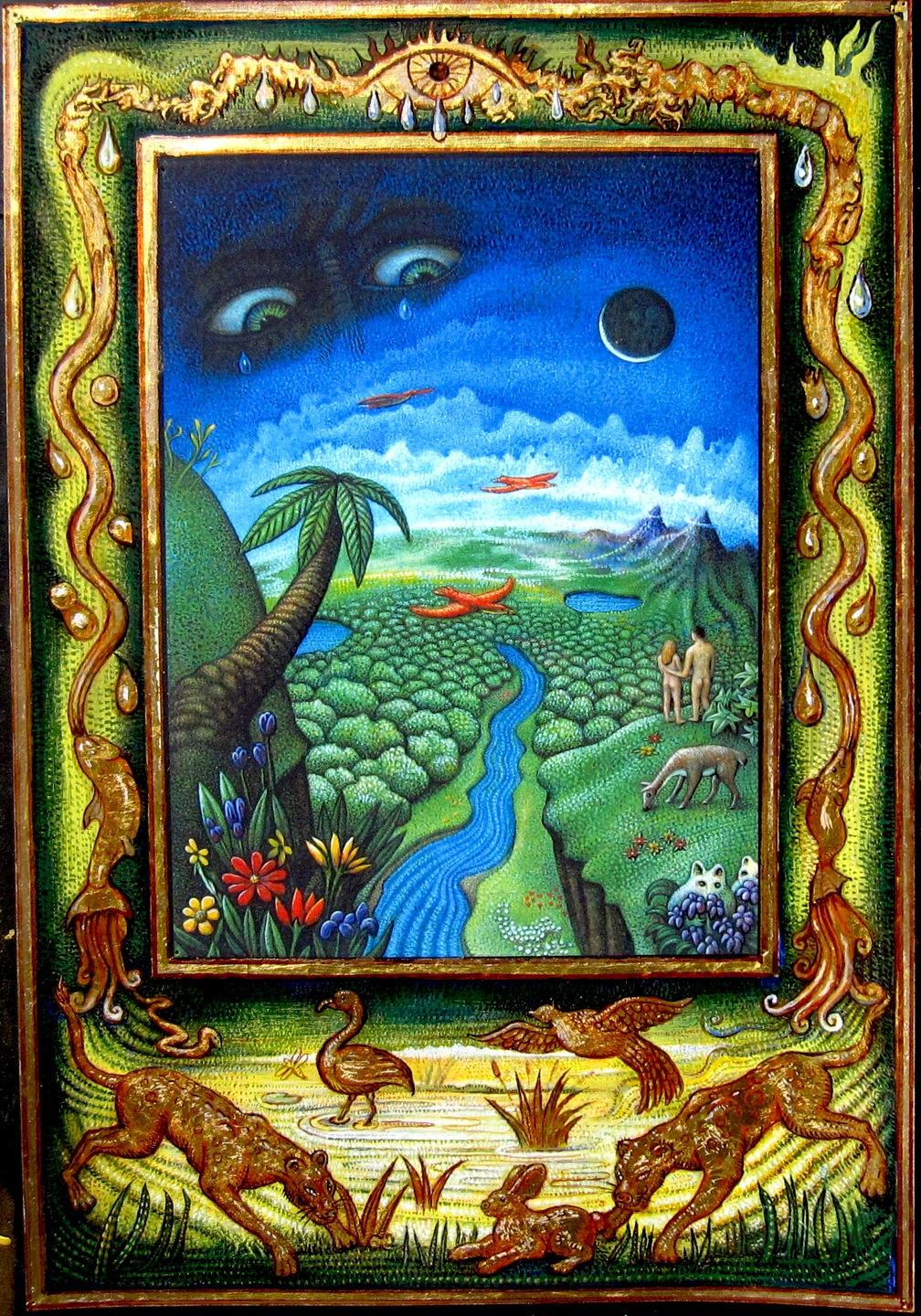

“Without a doubt, Terrance Lindall is the foremost illustrator of Paradise Lost in our age, comparable to other great illustrators through the ages, and someone who has achieved a place of high stature for all time.” Robert J. Wickenheiser, Ph. D.

Terrance Lindall's art for Paradise Lost appears on the 2008 cover of the Modern Library college text book, The Complete Poetry and Essential Prose of John Milton, Edited by William Kerrigan, John Rumrich and Stephen M. Fallon.

Holt Rinehart & Winston used another Lindall Paradise Lost image in a 2009 high school textbook, with a first run of 370,000.
Cambridge University Press uses another Lindall illustration on the cover of the 2014 Cambridge Companion to Paradise Lost.
Above: The renowned Milton collector D. Robert J. Wickenheiser with his copy of the Lindall Gold Folio of Paradise Lost and patron Estelle Levy
FROM THE ROBERT J. WICKENHEISER COMMENTARY
“The Paradise Lost Elephant Folio," in particular, is a hand -embellished and gold illuminated 13 x 19 inch book containing 14 full -page color 1000 dpi prints with 23.75 carat gold leaf edging on Crane archival paper. Each illustration is signed by Terrance Lindall, some pages with hand -painted illustrated or decorated borders and large, carefully embellished head - or tail-piece illustrations, others with historiated initials with 23.75 carat gold leaf embellishments. All add to the depth and meaning of a gi ven illustration of Lindall’s synopsized Paradise Lost (1983) appearing across from an illustration. For the Elephant Folio, Terrance Lindall is also providing a final painting, The Celestial Orbit, as a frontispiece. It is Lindall's "ultimate statement" as an artist's interpretation of Milton's great epic. This painting will only be produced as a print for the Elephant Folio and will not be reproduced for collectors as a signed print in any other format.
“ And while Lindall may now think that he has finis hed his work with Milton, he hasn’t, because Milton lives within Lindall in a special way, as surely as Lindall remains dedicated to bringing Milton alive to new generations in fresh and vibrant new ways, doing the same for countless generations in centuries to come.In his folio edition and the illustrations in it, Terrance Lindall shows the influence by certain great master illustrators of Paradise Lost through the centuries before him, especially with the inclusion of richly illustrated margins for each c olor illustration, the margins colored in 23.75 carat gilt and consisting of brightly colored details drawn from the epic in order to advance the meaning of the given illustration. Moreover, again in the tradition of certain great master illustrators of Milton‘s Paradise Lost through the centuries, historiated initials, in imitation of the initial letter in an illuminated manuscript, each in rich gilt and bright colors, are used as the first initial of a section and decorated with designs representing scenes from the text, in order to heighten the intensity of the cumulatively related details in each component part: illustration, border, and historiated initial.
“ The illustrated borders in the elephant folio are complete paintings in themselves. Although t he border art focuses principally on elements of design, they also sometimes tell stories or make commentary about what is illustrated in the featured central painting. The borders likewise pay tribute to both humanity’s great achievements, such as music, dance and architecture, as well as tribute to those individuals and institutions and friends who have had important influences on Lindall’s ideas, or who have shown substantial support or affinity.”

INTRODUCTION TO THE GOLD ILLUMINATED PARADISE LOST SCROLL
by Yuko Nii of the Yuko Nii Foundation

“The written word skims in through the eye and by means of the utterly delicate retina hurls shadows like insect legs inward for translation. An immense space opens up in silence and privacy, a space where literally, anything is possible. “ John Updike Updike’s is a wonderful description of why the written word cannot be superseded and why the written word will endure. Written words in a master’s hand can conjure landscapes, colors, sensations, music, philosophy and artistic visions without confining them. And as the words are scanned, the receptive and imaginative reader, a "sine qua non" part of this formula or process, brings them to life. As John Milton said “Books are not absolutely dead things!”
With Paradise Lost, the written word in it’s greatest form, Milton was able to evoke Updike’s “immense space” and project spectacular landscapes of both heaven and hell, and create also the monumentally tragic character of Satan, courageous yet debased, blinded by jealousy and ambition, heroic nonetheless. The blind poet brings powerful visionary life to one of the world's greatest stories, id est, the Western legend of man’s creation and fall, a story encompassing philosophical concepts of free will, good and evil, justice and mercy, all presented with the greatest artistry to which the written word can aspire.
“The artist Terrance Lindall came to Milton while pursuing a double major in Western Philosophy and English Literature, graduating Magna Cum Laude from Hunter College of the City University of New York. Paradise Lost, this “greatest work in the English language," enraptured Lindall because it encapsulates his metaphysical, epistemological and axiological philosophies. Today Terrance Lindall’s paintings for John Milton's Paradise Lost are perhaps the best-known illustrations for this epic outside of those by William Blake and Gustave Dore'. It appeared in the popular Heavy Metal Magazine around 1980 and one of the images appears on the 2008 cover of Complete Poetry and Essential Prose of John Milton, Random House 2008, edited by William Kerrigan, John Rumrich and Stephen M. Fallon. Holt Rinehart & Winston uses another Lindall Paradise Lost image in a 2009 high school textbook, which had a first run of 370,000.
Lindall believes that insight into Milton and the aesthetic and intellectual pleasures of Paradise Lost can elevate every individuals experience in education, thought and human endeavor...through the inspiration of the "written word." Lindall's Gold Illuminated Paradise Lost Scroll is a final and complete tribute to his love and sincere gratitude for Milton's great contribution to humanity. “
T he Gold Paradise L ost Scroll of Lindall

Terrance Lindall completed on December 8, 2009 what is considered by the few who have seen it already to be the most unusual painting for Milton's Paradise Lost ever done. It is in the form of a scroll that reads from right to left like a Torah. It is 14 inches high and 48 inches long with several highly detailed 24 K (23.75) gold illuminated miniatures.

Ten (10) highest quality Giclee prints facsimiles on canvas and signed by the artist have been produced. They are the same size as the original (with border 50” x 17”) and they look exactly like to original painting in every detail except for the use of gold leaf on the original. As of this printing only three remain available.
One Hundred (100) slightly smaller Giclee prints on watercolor paper (with border 45” x 15.3” are being produced.
This facsimile edition of the Gold Scroll has already been purchased for the following renowned collections:
1) Huntington Library in California. The Huntington’s highlights include one of the world’s most extensive collections of William Blake material, most notably the original illustrations for Milton’s Paradise Lost.
2) The University of Pennsylvania Rare Book Collection, which holds over 560 exemplars of books printed in Europe from movable type before 1501. Sixtysix of these titles are the only recorded copies in North America.
3) The University of Kentucky whose collections include many famous artists.
4) The Alexander Turnbull Milton Library of the National Trust of Zealand
5) The collection of Robert J. Wickenheiser, one of the world’s foremost collectors of Milton books and original illustrations for Milton’s works.
6) Dr. John Geraghty, notable collector of Milton books.
Purchases of the signed and numbered facsimile support the collections of the YNF.
Info.: milton@wahcenter.net

Above: Terrance Lindall with noted Milton scholar and collector Dr. Joseph Wittreich in front of Lindall’s Paradise Lost Altarpiece, another unique interpretation of Milton’s epic.


The Lindall Traveling Elephant Folio

A third 13 X 19 inch elephant folio has been produced for tour. It contains the complete synopsized version of Paradise Lost plus the Wickenheiser commentary and all of the illustrations as giclee prints. There are also many original drawings and decorations by Terrance Lindall and even some 24 k gold leaf appointments. It is an impressively large folio designed to engage the viewer who will actually be able to open the book and turn the pages, not usually allowed for in rare book collections, a great way to engage students of Milton!

Pages from the Traveling Elephant


The Lindall Grand Elephant Folio

“There will be nothing like it in the world of books and manuscripts.” Terrance Lindall Terrance Lindall has always been fascinated that the Lindau Gospels with it's astounding bejeweled gold cover. "Lindau" is very much like his own name "Lindall." The "U" in Lindau might be two "L"s looped. There is also the famous Lindesfarne Gospels. Since the "Lind"s of these great manuscripts have always been pointing at him in some fashion, Lindall guesses that his subconscious has always been working toward making something like them, maybe greater. Now Lindall has a collection of loose gem stones that are quite nice and some very large (rubies, emeralds, sapphires, citrons, etc.) . The crown jewel is the 134 K. Emerald seen below superimposed on the the cover of the Lindau Gospel. That emerald has always represented to Lindall the green Garden of Eden as Milton describes it "hanging in a golden chain this pendant world."
Because of the workmanship involved, this production may take a long time. Contributions to the costly project will be recognized on the last page of this unprecedented production in various categories according to the amount contributed. If you would like to have your name so honored down through the history of Western art and literature, contact Terrance Lindall directly at tlindall@gmail.com
Major contributors will receive signed artist proof pages, as Lindall always honors those

Inset: Possible cover design for the Grand Elephant


Please contribute to this historical production and be listed for eternity with other contributors to the Milton legacy!

Info: Milton@wahcenter.net
Right: Terrance Lindall with Steve Fallon next to the Milton Bookpress bearing a replica of the Milton Shield.

 Above: Professor Steve Fallon, President of the Milton Society, paging through the Lindall Grand Elephant Folio Pages on a visit to The Yuko Nii Foundation in 2016.
Above: Professor Steve Fallon, President of the Milton Society, paging through the Lindall Grand Elephant Folio Pages on a visit to The Yuko Nii Foundation in 2016.
The Yuko Nii Foundation Association Books


Book label of Madam Pomfret in her 1688 first illustrated edition of Paradise Lost. Madam Pomfrret was the Lady of the Bedchamber to Queen Carolyn.


In 1755 Henrietta Louisa Jeffreys, Countess of Pomfret, donated a substantial collection of Greco-Roman statuary to the University of Oxford.
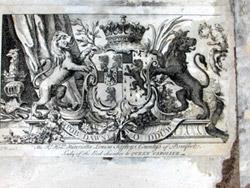
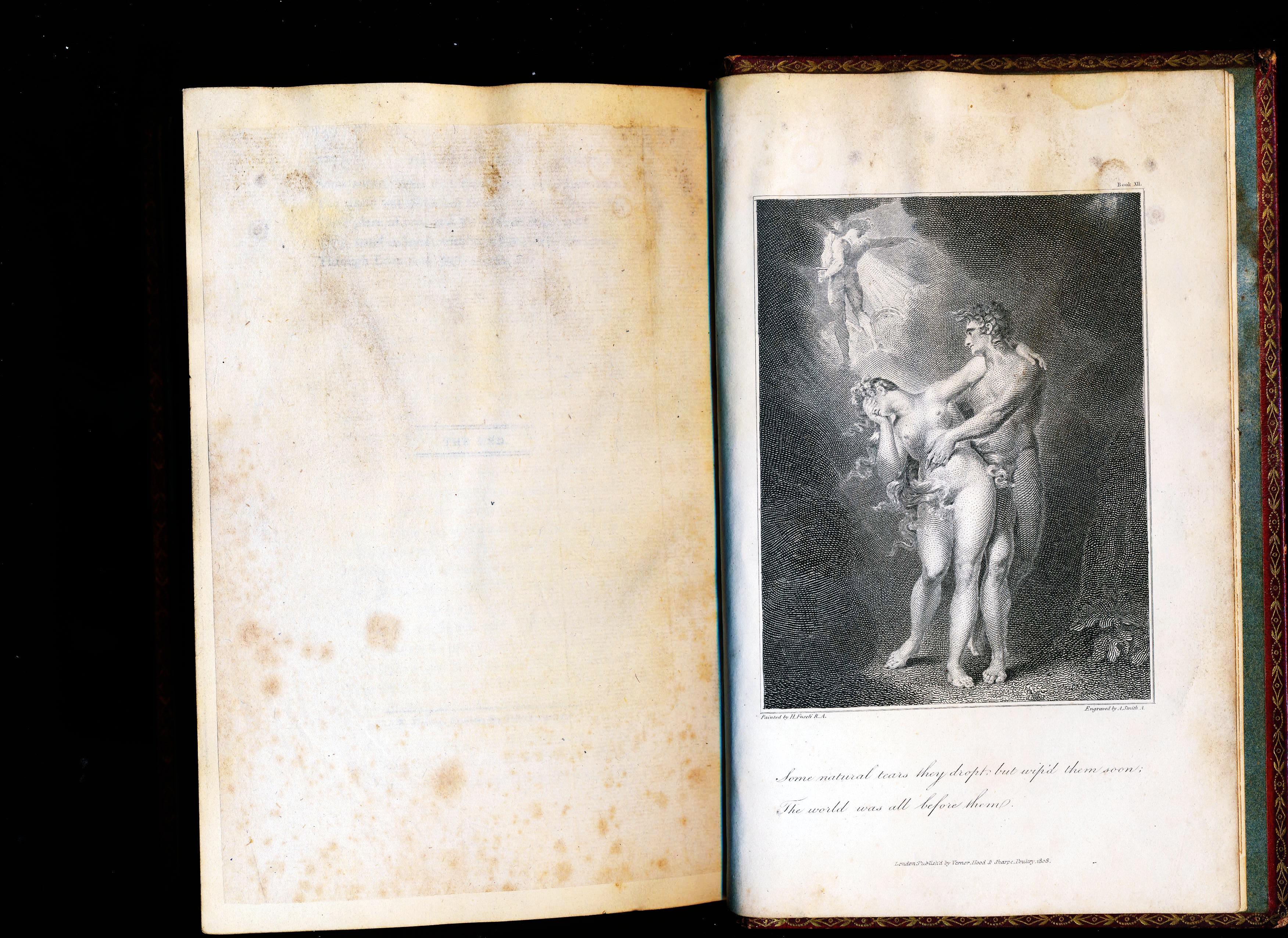


THE FEATURES OF THE BOOK

1) The Henri Fuseli (1741 – 1825) engravings by A. Smith in this book were done while Fuseli was alive in 1808. He is certainly as great an illustrator of Paradise Lost as Blake. The Wickenheiser collection contains an 1802 version.
The first of Blake's Paradise Lost, the Thomas set, were done in 1807. In 1799 Fuseli exhibited a series of paintings from subjects furnished by the works of John Milton, with a view to forming a Milton gallery comparable to Boydell's Shakespeare gallery. There were 47 Milton paintings, many of them very large, completed at intervals over nine years. The exhibition proved a commercial failure and closed in 1800.
2) The Royal & Historical Association: bookplate of E. Neville Rolfe, Beecham Hall with a dedication note by A.R. (Agnes Rolfe, Neville's wife) 1815 and a late 19th c. note describing in detail Dore's VALE OF TEARS (1883), on the 1815 exhibit of Dore's last painting at the Dore Gallery, London. Strickland Charles Edward Neville Rolfe, born in 1789, eldest son of General Neville of the Royal Artillery. Educated at Wadham College, Oxford, BA 1812, MA 1816, and subsequently became domestic chaplain to the Duke of Kent in 1814 and to the Duke of Somerset in 1825. He became domestic chaplain to the Duke of Kent in 1814 and to the Duke of Somerset in 1825. 1st Duke of Kent and Strathearn (1767–1820), was Prince Edward, fourth son of George III and father of Queen Victoria. .
Neville's first wife, Agnes, was the only daughter of Henry Fawcett, MP for Carlisle who was Sheriff, Bombay 1785; capt. Bombay fencibles 1799. They married in 1814 and had five sons and four daughters. In 1833 he married Dorothy, widow of the Rev TT Thomason, Chaplain to the Honourable East India Company. It is known that he was an enthusiastic collectorand invested time in both natural and archaeological items, as well as having a keen interest in art. Rolfe had had a number of artists, (possibly Fuseli) staying for long periods to study artistic endeavours at Heacham Hall. It is said that he had a large coach built in which he took these artists on excursions to draw and paint buildings or articles of interest in and around the area. He was especially interested in the area of Norfolk and part of his collection of portraits of Norfolk celebrities, original drawings, topographical and antiquarian, were sold by Sotheby's. Some of these pieces were used to extra illustrate 'Blomefield's History of the County of Norfolk' (compiled by Francis Blomefield and published in 1805). Later, in 1929, a number of water-colour drawings from the collection were also used to illustrate a publication compiled by his great grandson, Clement RolfeIngleby, and entitled 'A supplement to Blomefield's Norfolk.'
3) The book also has a late 19th c. note describing in detail Dore's VALE OF TEARS (1883), on the 1883-later exhibit of Dore's last painting at the Dore Gallery, London. During its twenty-four year lifespan, the Doré Gallery and its twenty or so canvases received approximately 2.5 million visitors. In 1892, most of the paintings were sent to the United States to be exhibited in a touring exhibition lasting until 1898. They then sank into oblivion. They were rediscovered in 1947 in a Manhattan warehouse, sold at auction and split up.
The size of the book is 8vo (octavo).This size is made by printing eight pages of text on each side of a sheet, which was then folded three times to form gatherings of eight leaves or sixteen pages each handsomely bound with gorgeous red morocco leather gold-gilt framing of both front and back covers, as well as gilt titling and ornamental compartments on the spine 5 raised bands brilliantly gilt golden edged pages printed half-title and title pages engraved vignette title, plain green endpapers




Bookplate with armorial of E. Neville Rolfe, Heacham Hall

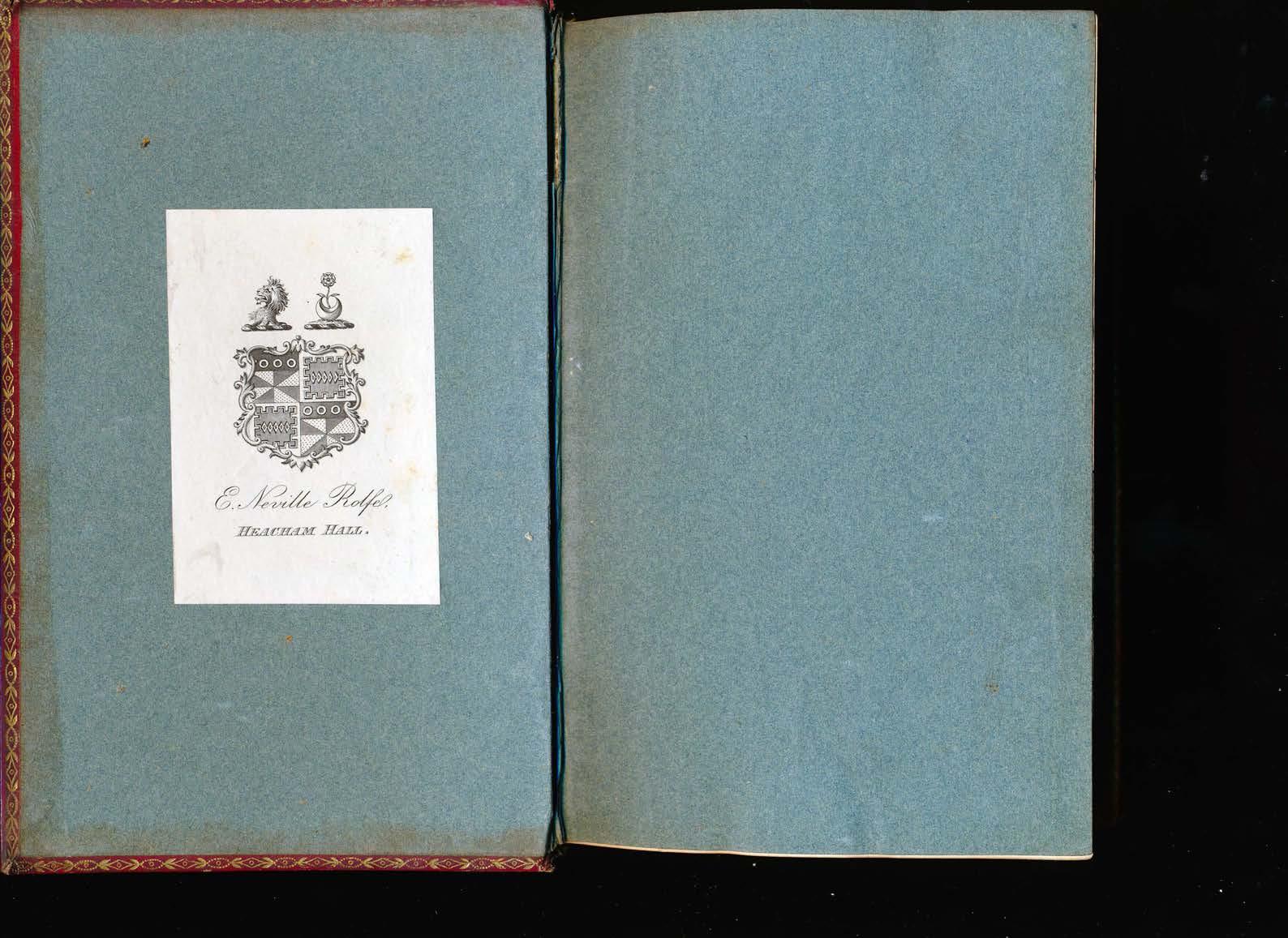
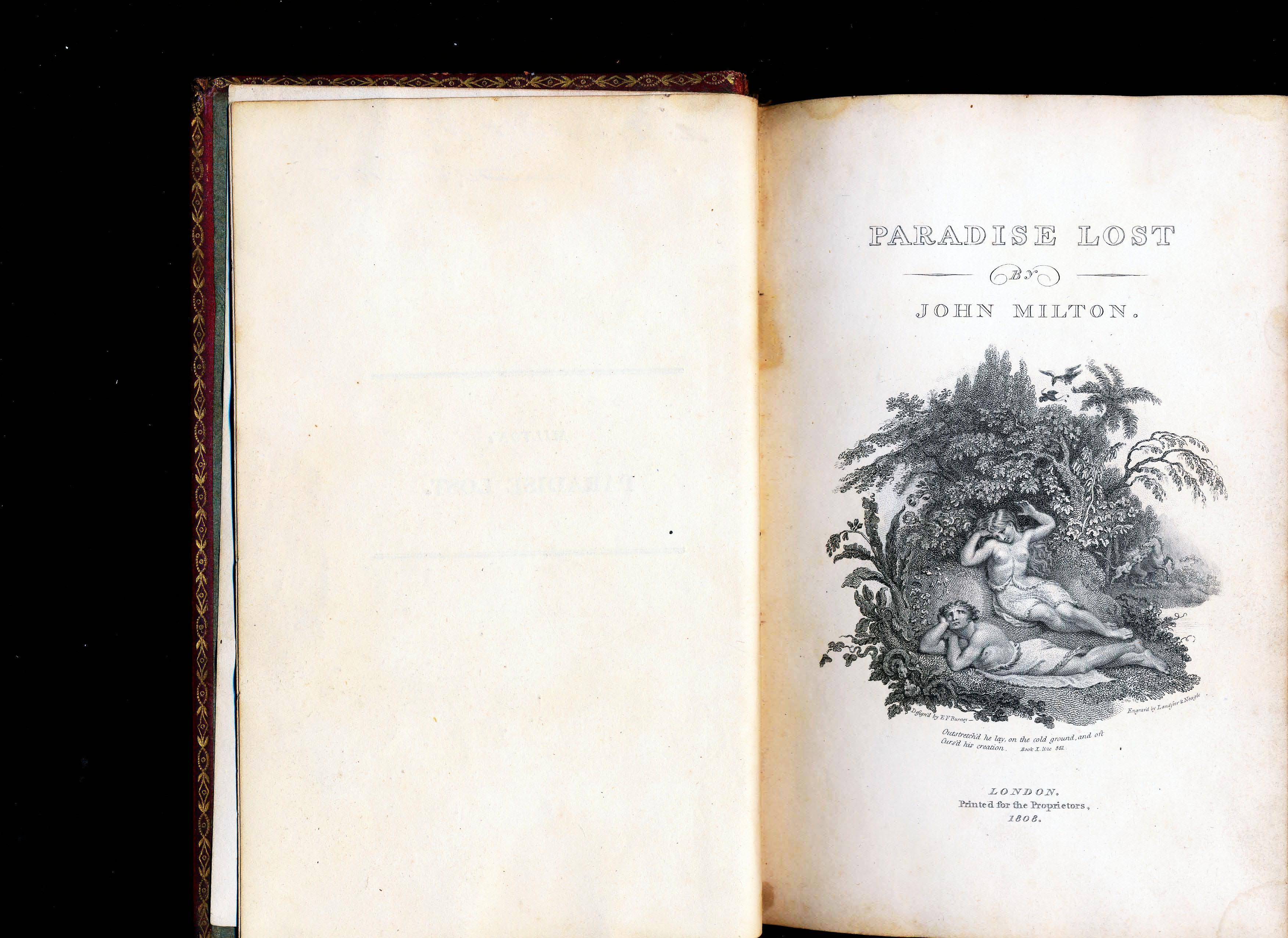
Beautiful Frontispiece
A dedication note by A.R. (Agnes Rolfe, Neville's wife) 1815

The dedcation reads:

”A.R. to W.C. & W.C. to his dearest J.C. – 1815”

Title page









Between the pages of the Fuseli Paradise Lost is a hand written “review” of the showing of Gustave Dore’s last painting, The Vale of Tears. Also included is a newspaper announcement of the exhibit.




Other illustrations in the book are by Hamilton



JOHN MILTON'S PARADISE LOST
The Grand Elephant Folio
ILLUSTRATED AND SYNOPSIZED by
TERRANCE LINDALL
Many original large format drawings plus 14 gilclee prints of the original oil paintings
Introduction by Yuko Nii
Commentary by Robert J. Wickenheiser, Ph.D.


17 x 32 inches!
THE LARGEST FOLIO OF JOHN MILTON’S PARADISE LOST EVER PRODUCED!
“Without a doubt, Terrance Lindall is the foremost illustrator of Paradise Lost in our age, comparable to other great illustrators through the ages, and someone who has achieved a place of high stature for all time. Throughout almost four centuries of illustrating Milton’s Paradise Lost, no one has devoted his or her life, artistic talents and skills and the keenness of the illustrator’s eye more fully and few as completely as Terrance Lindall has done in bringing to life Milton’s great epic. He has also devoted his brilliant mind to studying Milton, his philosophy, and his theology in order to know as fully as possible the great poet to whom he has devoted his adult life and to whose great epic he has devoted the keenness of his artistic eye in order to bring that great epic alive in new ways in a new age and for newer ages still to come.
Dr. Robert J. Wickenheiser, Milton Collector


"There is, to the best of my knowledge, no other privately held collection that even remotely begins to approach the Wickenheiser Collection in scope, range, or importance."
G. W. Stuart, Jr.,
antiquarian book dealer and Milton specialist
Here are a few pages from Book One –
The Fall of Satan

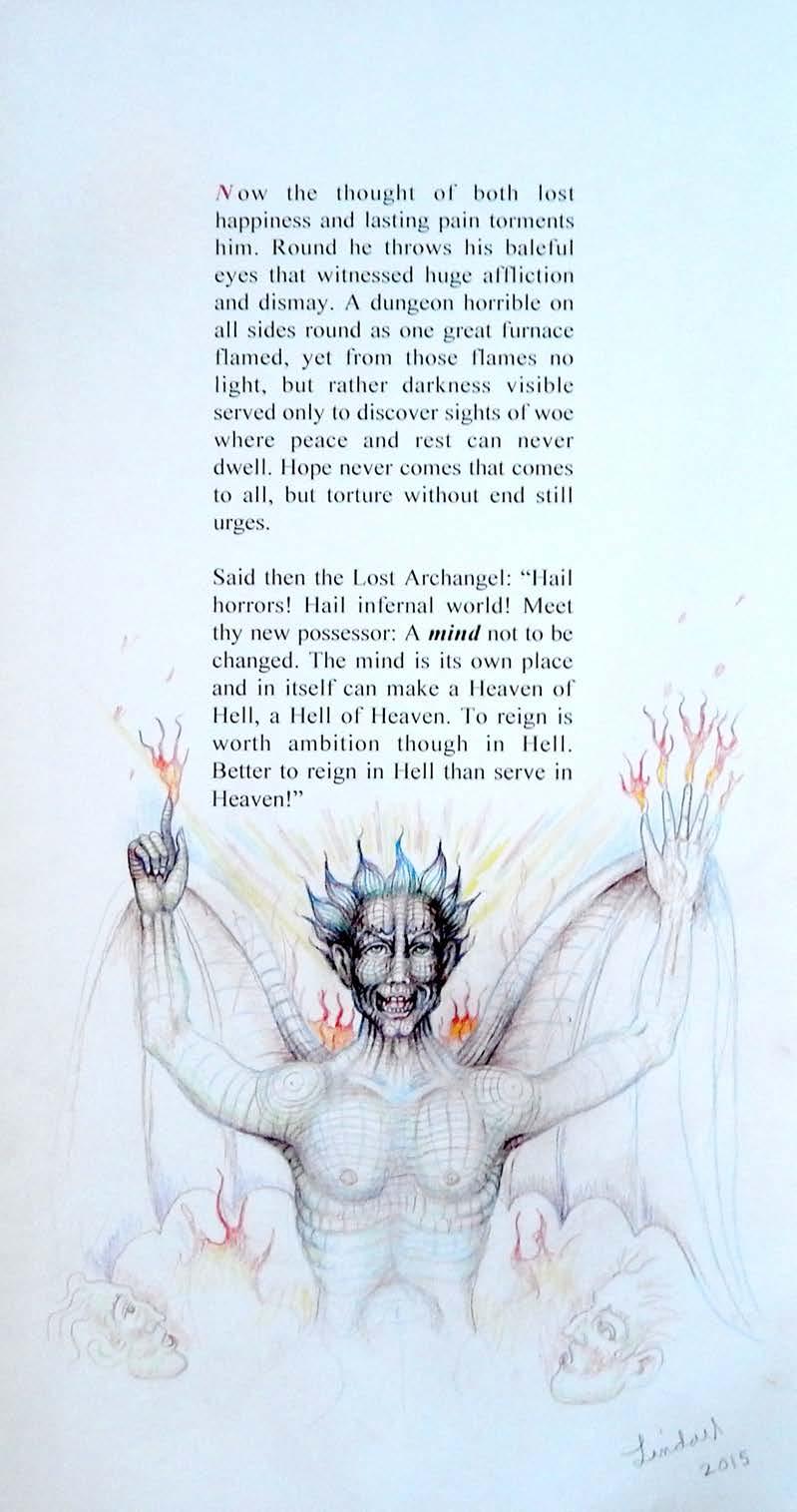

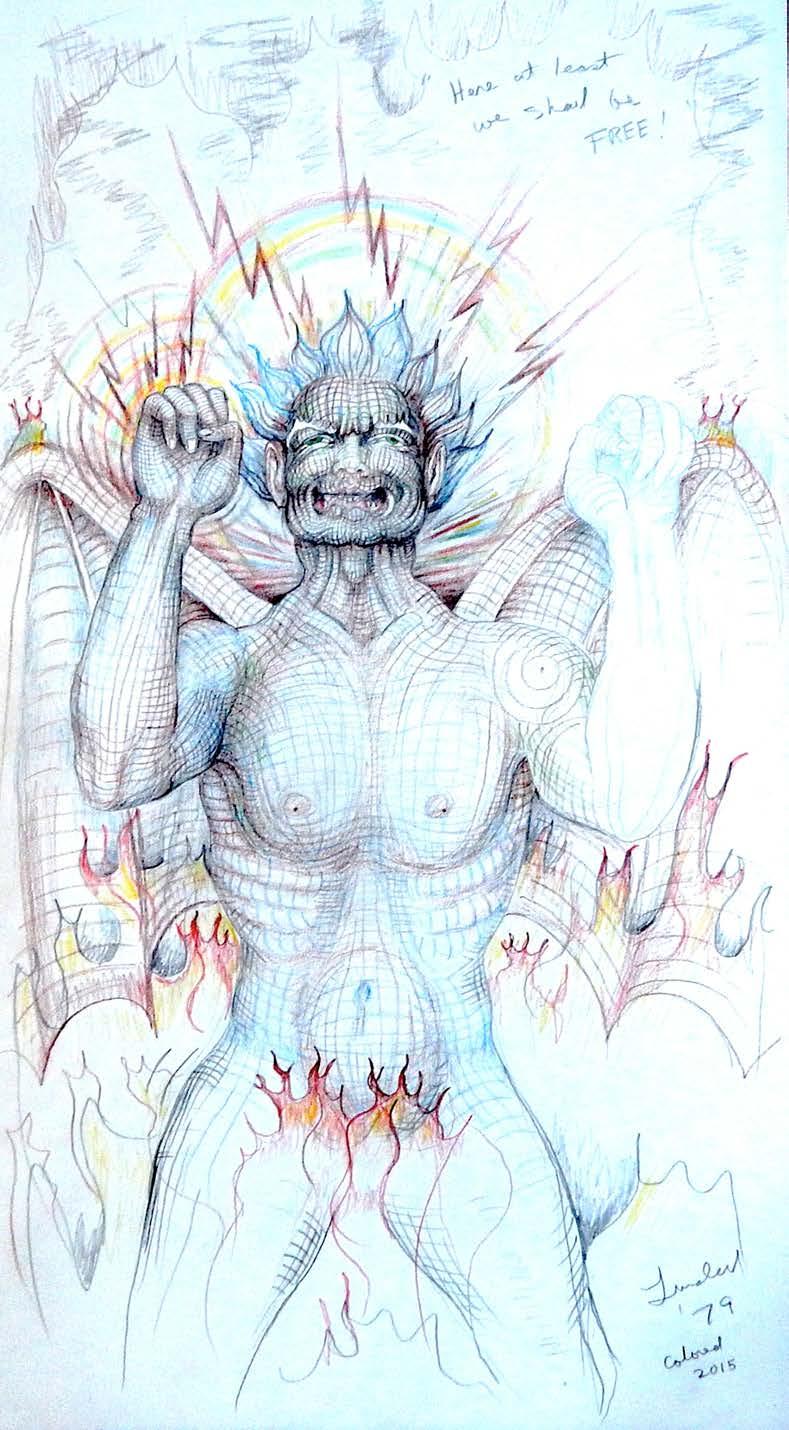

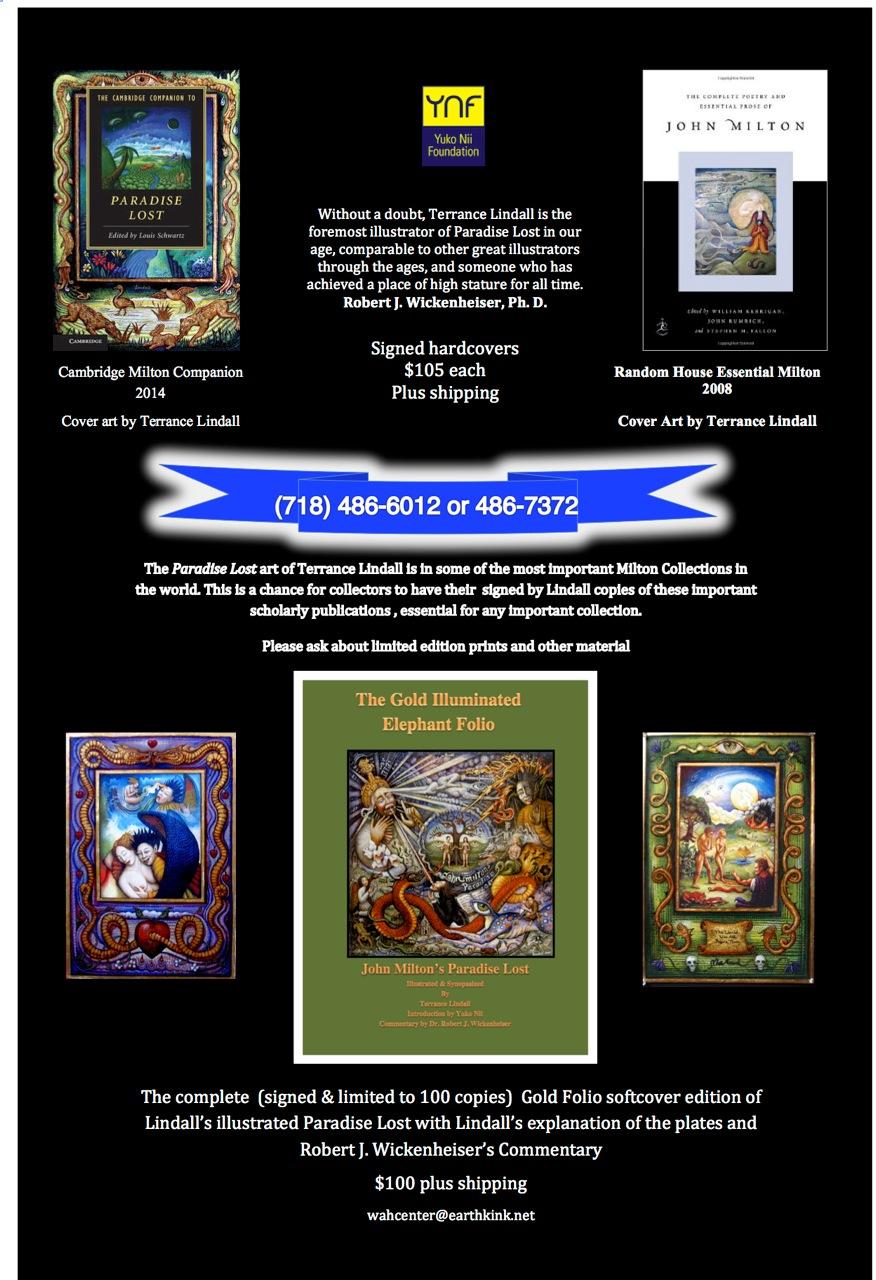

$150


THE MADONNA OF MONSTERS by Terrance Lindall. 2016 13 x 19 signed limited edition Giclee print $1,000


17thc. French Tapestry border 116 inches


























 Right: 17th C. Torah Scroll of the Book of Genesis, 23 feet long
Right: 17th C. Torah Scroll of the Book of Genesis, 23 feet long





























































 Above: Professor Steve Fallon, President of the Milton Society, paging through the Lindall Grand Elephant Folio Pages on a visit to The Yuko Nii Foundation in 2016.
Above: Professor Steve Fallon, President of the Milton Society, paging through the Lindall Grand Elephant Folio Pages on a visit to The Yuko Nii Foundation in 2016.















































